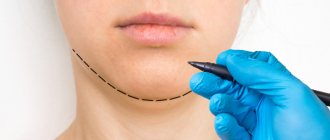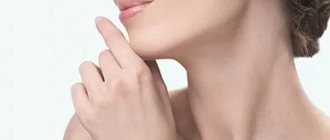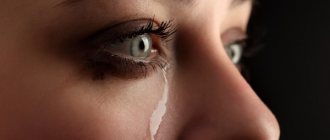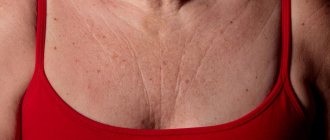It is not a fact that a “strong-willed” chin is evidence of a person’s strength and fortitude. History knows a lot of examples when truly strong-willed people had a completely different chin shape. For example, the strong character and steely will of Frederick the Great, apparently, had nothing to do with his quite ordinary oval face.
If you are not satisfied with the shape of your chin, then do not worry - it is easy to fix. Mentoplasty and modeling of the shape of the chin at the Medial clinic allows you to increase or decrease its volume according to the patient’s wishes, aesthetic or medical indications.
Chin augmentation
This operation is performed when the chin is underdeveloped and the bite is satisfactory.
Chin augmentation can be done in several ways.
Correction with implants .
Depending on the condition of the soft tissues, they are installed directly on the bone or in a prepared soft tissue pocket. There are several types of implants:
- special silicone inserts, solid or perforated;
- bioimplants from the patient’s own cartilage (ear, costal, or excess nasal tissue during simultaneous rhinoplasty);
- non-silicone porous implants reminiscent of the structure of corals. They take root easily and are firmly fixed by tissues due to their inward growth.
Osteoplastic correction . The protruding part of the lower jaw is cut down (horizontal osteotomy) and fixed in a new, extended position. For strength, the separated fragment is secured with a metal plate with screws. The displaced bone tissue always remains connected to the muscles of the floor of the mouth. This prevents atrophy and preserves the result of the operation for a long time. If the size of the moved bone fragment is not enough to achieve the required size, then contour plastic surgery is performed with one’s own fat (the remaining space is filled with one’s own adipose tissue).
When surgery is contraindicated
Surgical correction can solve a variety of problems, however, there are cases when chin surgery is impossible.
Mentoplasty will be canceled if contraindications are discovered at the preparation stage. We are talking about the following violations:
- blood clotting disorder;
- infectious pathologies;
- malfunctions of the immune system;
- any dysfunction of blood vessels, heart, kidneys or liver;
- oncopathology;
- inflammation, eczema or pustular lesions in the area of proposed plastic surgery;
- diabetes;
- pathologies of the oral cavity (including gum disease, pronounced caries, etc.).
Temporary contraindication – treatment of malocclusion using a brace system. Plastic surgery will be denied to pregnant and breastfeeding women, as well as patients with mental problems.
Chin reduction
Reducing correction is performed for heavy and protruding chins. It is more often considered a “female” procedure that allows you to acquire a delicate facial contour.
When reducing the chin, an osteoplastic transformation is performed, similar to an increasing correction. But the bone flap obtained with a horizontal osteotomy is moved not forward, but backward. This makes the chin more invisible. The fabrics are also fastened with screws or a mini plate. Once the bone has fully fused, the metal parts can be removed and the bone sanded down for a smoother-feeling surface.
If you need to significantly reduce your chin, part of the bone tissue is completely removed. With simultaneous dental implantation, it can be used to build up atrophied areas of the alveolar processes of the jaws (sinus lift).
Reducing correction requires careful modeling and formation of the correct facial contour.
Why is this necessary?
People usually undergo genioplasty procedures to change the appearance of their chin, but there are medical reasons for this surgery.
An example of this is retrogenia or drooping chin. Retrogenia can lead to obstructive sleep apnea, a sleep disorder in which a person's breathing repeatedly stops and starts throughout the night.
According to a 2022 retrospective study, researchers found that people with certain chin and jaw defects had a higher risk of developing obstructive sleep apnea. The risk was especially high if they were over 30 or overweight.
Double chin removal
This defect in appearance occurs due to excess adipose tissue and sagging muscles and other soft tissue structures that form the floor of the mouth, the upper part of the neck and the lower third of the face.
To eliminate a double chin, non-surgical liposuction and muscle correction are performed.
Non-surgical liposuction (cavitation) . Impact on tissues from the outside with ultrasonic waves, as a result of which fat is removed independently.
Muscle correction . To obtain an elegant contour, muscle tightening is performed after eliminating the fat pad. Depending on your age, this may be a thread lift or a platysma lift (the muscle that runs from the chin to the collarbone). In case of excess skin and in patients over 45 years of age, sagging tissue is resected.
Surgical liposuction.
The crushed fat cells are sucked out through a special cannula inserted into the tissue incisions.
We also recommend reading: How to remove a double chin?
What problems does correction solve?
In order for the face to look beautiful and harmonious, each part of it must be proportional.
The same applies to the chin - often people turn to surgeons precisely because of dissatisfaction with its shape (for example, if we are talking about a cleft, square or too sharp chin). Plastic surgery is also performed:
- if you have a double chin;
- with asymmetry of the problem area;
- if the face looks heavy due to the strongly protruding lower part;
- if the designated area is more consistent with the appearance of the opposite sex;
- when the upper part of the face is visually enlarged by a sloping chin;
- for any congenital or acquired defects (for example, underdevelopment of bone tissue).
Often, to achieve maximum aesthetics in this area, the surgeon performs one-stage plastic surgery of the neck and chin.
Features of the procedure
The manipulation is carried out under local anesthesia, sometimes it is supplemented with intravenous sedatives.
Tissue cutting is possible in two ways:
- inside the oral cavity (intradentally), in this case no visible traces remain outside;
- external access, under the chin. In the future there will be a small scar, over time it will become less noticeable.
The duration of the intervention depends on the technique, the purpose of the procedure and its complexity. For small changes, for example, when removing a double chin, which is considered the easiest option, 30-40 minutes are enough; when increasing the chin using implants or when injecting your own fat, it will take 1.5-2 hours, but a reducing correction, which is The most complex type of operation can last up to 2-2.5 hours.
The recovery period lasts about 2 weeks, and the full effect of the operation is visible after an average of 90 days.
How are we different?
- We compare ourselves to world standards. The clinic uses instruments, equipment and consumables from the world's leading manufacturers. Chin mentoplasty is performed using modern technology, which gives a predictable and stable result.
- We use reliable implant models. The American implants that we install last without problems for the rest of your life.
- We reduce the risks of complications to zero. Patients are carefully examined on the eve of surgery. The correction is performed by one of the best mentoplasty surgeons in the country.
- We put patient care first. We have created all the conditions for the psychological comfort of patients. Friendly staff, comfortable rooms, round-the-clock monitoring after surgery - all this helps our patients feel calm and confident.
- We offer a convenient payment system. The price for chin augmentation is calculated on an all-inclusive basis. If necessary, patients are provided with assistance in obtaining interest-free installments for surgery.
- We are at the forefront of plastic surgery. According to TOP 25 Diamond Companies & Persons, ours is in Moscow. And numerous grateful reviews from our patients confirm this.
Rehabilitation period
- At first, you will be concerned about pain, tissue swelling, and numbness of the skin in the area of intervention.
- If necessary, a special bandage will be applied to secure the site of the procedure.
- Intraoral access will require food restrictions: at first only liquid food is allowed with careful removal of its remains.
- It is recommended to reduce physical activity in the first days, limit visits to the gym for a month, and for people involved in martial arts to postpone training for at least 2-3 months.
Cost of mentoplasty
The price list shows the minimum price for chin augmentation. The final cost is calculated by the doctor during consultation, based on the volume and complexity of the surgical intervention. The announced amount will include the entire range of services related to the correction (surgeon consultations, anesthesia, surgery, hospital stay).
In 90% of cases, chin surgery is performed in conjunction with rhinoplasty. The cost of such a service is also determined individually - for two operations at once.
| Mentoplasty (chin surgery) | from 140,000 rub. |
Sign up for a free consultation
Recovery process
After mentoplasty, recovery is quick and you do not need to worry about scarring. If the incision was made under the chin, the scar will be small and invisible. If the incision was made inside the oral cavity, it will remain hidden.
Once the surgery is complete, the plastic surgeon will apply a bandage.
After the operation, there may be pain in the jaw area, so during this period it is better to limit yourself to a liquid diet. You may also experience stiffness around your chin and mouth for the first week after surgery.
Since surgery is always stressful for the body, it is better to reduce physical activity as much as possible in the first 10 days after surgery. You can then largely resume your normal schedule, but it is best not to do anything strenuous for three weeks after surgery. The specialist will give you more specific recommendations.
The chin may not be the first part of the face that people notice, but it has a strong impact on overall appearance. Change can even help improve self-esteem. Mentoplasty is a modern and safe method of correcting the shape of the face.
During the procedure, the surgeon makes an incision inside the lower lip or under the chin. The chin bone is then repositioned or an implant is placed through the incision.
Bely Igor Anatolyevich plastic surgeon, Doctor of Medical Sciences
Benefit
Chinplasty can change the aesthetic appearance of the chin
The placement and size of the chin plays an important role in balancing other facial features such as the nose, forehead and cheeks, which contributes to the overall harmonization of the face
Genioplasty can provide significant benefits for people who are unhappy with the appearance of their chin.
In an earlier study conducted in 2011 among 37 people who had sliding genioplasty procedures, more than 94% were extremely satisfied with their results.
Implant installation and bone mentoplasty are disparate operations, especially in the context of age-related changes.
A fundamental difference in terms of rejuvenation.
With an implant, we are essentially placing a plaque on the front surface of the lower jaw. And with bone grafting, we make a cut and pull out a bone fragment. This effect not only affects the shape of the chin and lower lip, but also the front surface of the neck: the tissues are stretched, emphasizing the submandibular and submental areas. This allows you to get rid of sagging neck and emerging double chin.
The second advantage of bone grafting: we try to make a cut in the place where the patient’s jowls are located. And when we push out the bone fragment, the jowls are redistributed.
An implant does not give such an effect, no matter what size it is. With bone grafting, we injure less the site of attachment of soft tissues to the periosteum, we do without wide detachment, and the soft tissues clearly follow the bone - they are stretched. And to install an implant, a wide detachment of soft tissue is required, and the excess skin will only be reduced to some extent.
In my practice, I used 3 types of implants:
Medpor, Ecoflon, Silicone. Medpor and Ecoflon are not bad. They have slight differences, but we work with both.
I think installing silicone on the surface of the bone is a bad idea. According to my data, bone tissue is reabsorbed underneath it: the implant gradually penetrates into the bone and causes erosion. The result is unstable, since under the silicone the chin will shrink over time.
With porous implants, degenerative bone changes are practically not expressed. There are no noticeable changes observed either in the photographs of the chin projection or in the x-ray. A porous implant does not behave like a foreign body; it does not penetrate the bone, but is surrounded by a capsule made from the patient’s own tissues.
Access.
I have never seen any oral surgeon make a cut from the submental approach. Access is always intraoral.
Plastic surgeons in the vast majority of cases perform implantation. Often the intraoral approach is equated to an osteotomy, and implantation to the external approach, although implantation can be performed through both approaches.
External access has one undeniable advantage: the level of the oral fissure does not change. By installing an implant from an external approach, we do not peel off all the muscle fibers of the mentalis muscle, but preserve the upper portion. Why is this important: the mentalis muscle is woven into the periosteum at one end, and into the skin of the chin at the other. When we perform a detachment from the intraoral approach, tearing off this muscle almost to the lower edge, the flap, which is now forced to cover not only the bone, but also the implant, slides down. Because it is only fixed at the bottom by bone. The mouth opening will lower and the lower teeth will be more visible. It ages your face and ruins your smile. It is difficult to correct such a consequence.
And if we insert the implant from below, through the external approach, and do not completely peel off the muscle, then the flap is fixed at the top, so the level of the highest point of the lower lip will not change. The flap is dragged from the submandibular (submental) region upward, and due to this the cover is increased. This is the advantage of external access.
Situations when it is impossible to replace the installation of implants with bone grafting are rare.
It is impossible to perform surgery if there is a very large deficiency of your own bone. This happens after a previous implantation, when erosion has eaten the bone; maxillofacial surgeries associated with the removal of cysts and neoplasms, impacted (unerupted) teeth and large bone loss. But in such cases, we most often do not need a colossal chin augmentation. Let's just say that patients with ongoing maxillofacial diseases have nothing to do with it.
When a really large volume of bone is required, there are several solutions:
1) Perform a stepped osteotomy, making not one horizontal cut, but two or three. The chin turns into horizontally cut “noodles”, these steps are moved forward and we get the opportunity to move the fragments relative to each other, after which osteosynthesis is carried out (connecting the fragments). This is a difficult technique that I performed once. The result is good, but it is very difficult to obtain.
2) If the patient has a long chin that is not protruding forward enough. The long symphysis (mental region in the median section) is always flat: during growing up, all growth potential went vertical, but did not move forward. In this case, we make a cut high, closer to the roots of the teeth, and we move the fragment not linearly, but with rotation: the lower edge rotates anteriorly as much as possible. And, since the fragment is large in height, we kill two birds with one stone: the chin will move forward more and shorten.
3) Chin-wing osteotomy. This is a “long wing” osteotomy: a long cut along the lower edge of the lower jaw, in which the lateral sections of the moved fragment are significantly lengthened. The technique is not easy, but with its help we are able to move the chin forward more than the length of the symphysis. We make a horizontal cut not only in the chin area, but extend the cut into the area of the lateral teeth, and in some cases to the posterior edge of the jaw branch. And when we push the lower “horseshoe” (the entire lower edge of the jaw body) forward, the anterior section may lose contact and, roughly speaking, hang in the air, but in the lateral section the contact will still remain. This achieves a very large extension in the anterior chin.
With this technique, we can move forward the lateral sections of the lower edge of the jaw body. And get what most of our patients like: a model appearance, when the chin and angles of the jaw are sharply outlined. The effect of cheek retraction appears, to some extent comparable to the widespread removal of Bisha's lumps: if the contour is emphasized, then the tissues of the cheek, which do not have bone support, will collapse on their own.
Box osteotomy
(“in the shape of a box”) I last did it about 10 years ago. A horizontal cut is made and two vertical cuts are made from it. The result is a chin fragment in the form of a box, which we can move back and forth. With large movements, defects form in the place of vertical cutting, which can be felt and sometimes even seen on thin girls. Therefore, we had to figure out how to close such a defect.
At a higher level of development of genioplasty is linear osteotomy.
. One horizontal cut is made, which smoothly goes into the posterior parts of the lower jaw. And in the place where the cut goes to the edge of the lower jaw, we get a smooth line without any ledge. Even after a large extension, you will not be able to feel any steps or irregularities.
Vertical movement does not create a defect. If a horizontal cut is made, extending into the lateral sections, and it is necessary to lengthen the chin fragment, we lower the osteotomized fragment down and install bone material into the diastasis (gap). This can be the patient's bone, taken from the bone sections, or a synthetic bone block, which is installed in the diastasis and fixed with mini-plates or bicortical screws. This way we achieve a good comparison and the defect will be completely closed.
Rehabilitation.
After the implant is installed, a capsule is formed around it, which takes about 6 months. Regardless of the implant material, the capsule matures for six months; this is a biological law. And with bone grafting, the only foreign body is a screw embedded in the bone. Therefore, although the operation itself is longer and more complex, there is nothing left to irritate the tissue, slowing down healing. Thus, with bone grafting, there is more trauma during surgery, but recovery is faster.
When installing an implant, noticeable swelling on the chin persists for a long time, since the foreign body causes:
a) lymphostasis;
b) the process of scarring, in most cases quite rough.
Recommendations for restrictions during rehabilitation are the same for bone grafting and implant installation. But the patients will look completely different.
To communicate with patients who have undergone orthognathic surgery, come to our forum in the section Plastic surgery in the cheekbones, jaws and chin








